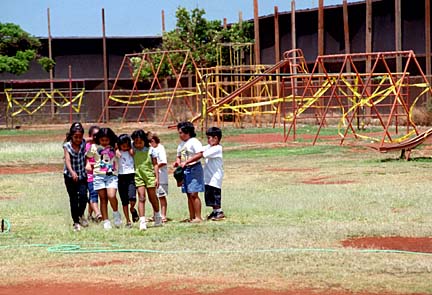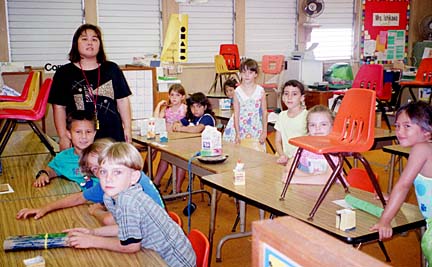Advertisement - Click to support our sponsors.


Students are cooling their heels
The hot list
while waiting for relief from
hot, smelly classrooms
The school under the 'cruel sun' By Crystal Kua
Star-BulletinWhen trucks arrive to haul trash from Ewa Beach Shopping Center, the odor of rotting garbage immediately bombards the classrooms of nearby Ewa Beach Elementary School.
"Mabaho," said Destiny Deponte, 7, using the Tagalog word for smelly. "It smells like someone farted."
Pinching her nose, Victoria Tolentino, 6, summed it up: "It's P.U."
On Maui, it's the heat, not the odor, that overwhelms. It sometimes gets so hot at King Kamehameha III Elementary School in Lahaina that students get sick.
On the desert-like Ewa Plains on Oahu, Pohakea Elementary School can't even install fans to help cool things off because it doesn't have enough electrical power.

Schools ranked 1 to 8 on a Department of Education "Heat Abatement" priority list cite heat, dust, tour-bus exhaust, jet overflights, wastewater discharge, truck engines and assorted environmental calamities as reasons why they need air conditioning.But unlike Maili Elementary School, whose problems were widely publicized and which was ranked ninth, most of the other schools are not likely to get relief.
"I don't hold out too much hope," said Louis Vierra, principal of Campbell High School, ranked No. 8 on the list.
Vierra and others believe it will be years before their schools will get air conditioning because there's not enough money to fund all the requests.
The cost to outfit the first eight schools is more than $35 million, but the current fiscal year's appropriation is a mere $1 million; next year's is $1.5 million.
State Schools Superintendent Paul LeMahieu said the schools are appropriately ranked.
For example, Kamehameha III Elementary School should be ranked at the top, he said, because tour buses that park nearby blow diesel fumes into classrooms, posing a health risk.
Work is under way to fix the problem and get Kamehameha III off the list, but there is more need than money and the other schools may have to wait, he said.
Maili Elementary School was able to get money after successfully lobbying the Legislature. After years of being subjected to pig and chicken farm smells, fly infestation and hot classrooms, Maili Elementary School students marched on the halls of the state Capitol to publicize their problems.
This past week, lawmakers approved a state construction budget that included $3.16 million so Maili can start installing air conditioning.
Maui's south coast
The Nos. 2 and 3 schools on the list -- Kihei Elementary and Lokelani Intermediate -- are located along the dry and dusty coastline of South Maui.Parents and teachers said conditions have improved in the past several years, mainly because of their own efforts.
They've organized fund-raisers to buy air-conditioning units and ceiling fans.
"We just said 'I don't think we can wait any longer,' " said Jeanne Simanek, past president of Kihei Elementary's Parent Association. "You wouldn't send your kid to a baby sitter in this kind of heat."
She said parents and teachers took about two years to put ceiling fans into 30 classrooms. Air conditioners also have been put in portable classrooms.
She said the association couldn't put air-conditioners in multiple classroom buildings because the buildings didn't have enough electrical power.
"You're talking a lot more money than a PTA can afford in a fun run," she said.
The cost of upgrading the electrical system -- hundreds of thousands of dollars -- is a secondary obstacle for older schools, some 30 to 50 years old, that are waiting for air conditioners.
At Lokelani Intermediate, the Parent Teachers Association also has raised money to buy and install air-conditioning units in most of the portable classrooms.
Vice Principal Jay Petrakis describes it as a "hodgepodge" of air conditioners, some that work well and others that don't and make a lot of noise.
The Ewa Plain
At Pohakea Elementary, students are encouraged to bring water bottles to keep hydrated."That helps them to feel a little comfortable, if they all bring their little water bottles and take a sip," Principal Beverley Tasato said.
For "those of us on the Ewa plains, it's hot and dusty," she said. "It's like living in Arizona."
Pohakea is one in a complex of schools that feeds into Campbell High School, all of them having to deal with noisy jets flying overhead, as well as dust and heat. Temperatures in portable classrooms can reach into the 100s.
Four Ewa schools are near the top of the "Heat Abatement" list. At No. 4, Pohakea is the highest-ranked Oahu school.
"Our plan at this time is to get fans, but what has been a stumbling block is the electrical (wiring)," Tasato said. "
At Campbell, Vierra said a brisk breeze can be a saving grace, especially when summer school is in session.
"If we get a cross breeze, it's not unbearable in the classroom," he said.
Studies have shown that if students are kept comfortable, they will be more attentive and involved in the classroom, Vierra said.
Noise, stench and dust
At Ewa Beach Elementary, Principal Eileen Ono notices the frequency of the jets flying overhead. This past week, the air traffic was busier than usual. "They're five to seven minutes apart," Ono said, as she looked at her watch and the jet that just passed.There's also noise and odor from trucks unloading goods at the Ewa Beach Shopping Center. Drivers leave their engines running to keep their refrigerated compartments cool, Ono said. "Oftentimes, students with soft voices, you can't hear."
On top of that, the stench from the garbage being emptied into trucks is overwhelming. "I've got to close my nose," said J.C. Mae Agnir, 6, whose classroom building is the closest to the back of the shopping center.
Fine dust also finds its way through the windows and into computer equipment and over everything else.
Keeping the dust, noise and smell out is not simple.
"We would never close the windows or we would die," Ono said.
"It's hard studying," Agnir added. "We have to open the windows."
On a military base
Military families who move here from the mainland sometimes find it difficult to adapt to the warm, humid climate, said Hickam Elementary Principal Lois Matsuda.In addition to the hot weather, life on a military base like Hickam also can mean being exposed to fumes from jet fuel.
"We are situated next to the Pearl Harbor industrial area," which means dust, noise and odors, Matsuda explained. However, the odors were brought under control last year, she said. "It used to be a whole lot worse."
The school has air conditioned some of the hotter classrooms with help from the parent teacher organization and the base.
Pohakea's Tasato said she's glad her school is No. 4 on the priority list, but the reality is that most students don't know what classrooms are like with air conditioning. "They've become acclimated," Tasato said.
"We don't expect anything, we live with it," Ono said.
Maui correspondent Gary T. Kubota contributed to this story.
| | |
These are the top nine schools affected by excessive noise, ventilation and heat problems, and awaiting funds for air conditioning and other corrective measures, according to the Department of Education: The heat is on
(School name, cost estimate, school district)
1. Kamehameha III: Cost estimate not available, project under way, Maui
2. Kihei Elementary: $4.6 million, Maui
3. Lokelani Intermediate: $4.1 million, Maui
4. Pohakea Elementary: $4.3 million, Leeward
5. Hickam Elementary: $4.5 million, Central
6. Ewa Beach Elementary: $2.8 million, Leeward
7. Ilima Intermediate: $5.2 million, Leeward
8. Campbell High School: $11.1 million, Leeward
9. Maili Elementary: *$3.4 million, Leeward
*Original estimate. Project now expected to cost close to $5 million
| | |

They’re all hot topics
By Gary T. Kubota
at the No. 1 school
Maui correspondentLAHAINA -- The No. 1 public school on the state's "Heat Abatement" list is in a town known in Hawaiian as the "cruel sun" -- Lahaina.
When the temperature is in the 80s along Lahaina streets, it's in the 90s in portable classrooms at King Kamehameha III Elementary School, Principal Richard Paul said.
"We're kind of out of the tradewinds here," he said.
Paul said contractors have been on campus recently to examine the facilities and develop bids on the air-conditioning contract.
Most of the school, made of cinder-block walls, was constructed in 1957. Nine portable classrooms have been built as enrollment has increased to 650 students from kindergarten to fifth grade.
Only a portion of a building that includes the library and administrative office has air-conditioning.
Paul said walking into some portable classrooms is like "entering an oven."
Students in first-grade teacher Joni Ishikawa's class keep water bottles near their desks.
"When it's hot, you pour water on your head," said 7-year-old Kacie Craig.
Some classrooms are also close to the noise and diesel fumes of tour buses parked at adjacent Lahaina Harbor.
Shutting the window louvers cuts off the noise and fumes but also increases the heat.
September and October are the hottest months -- times when some students fall ill and are taken to doctors.
"The doctors say their illness is heat-related," Paul said.
"People are literally walking with sweat on their faces. It's very miserable. They don't want to go to recess. It's too hot. It doesn't produce an atmosphere conducive to learning."
Ishikawa said when the wind blows hard during dry months the dust from the harbor becomes so thick in her classroom that she and the students retreat to another side of the campus and play activities underneath a tree.
Even her plants wither in the heat of the classroom. She puts them in a closet near the wash basin.
Students have difficulty cooling their bodies and concentrating on their school work when they return from recess.
"They get more sluggish," she said.
Elsie Makekau, another teacher, said the children don't complain because they're not aware of the positive effect on learning when a classroom is cooler.
"Professionals would not work under these conditions," she said.
"And we expect kids to learn?"